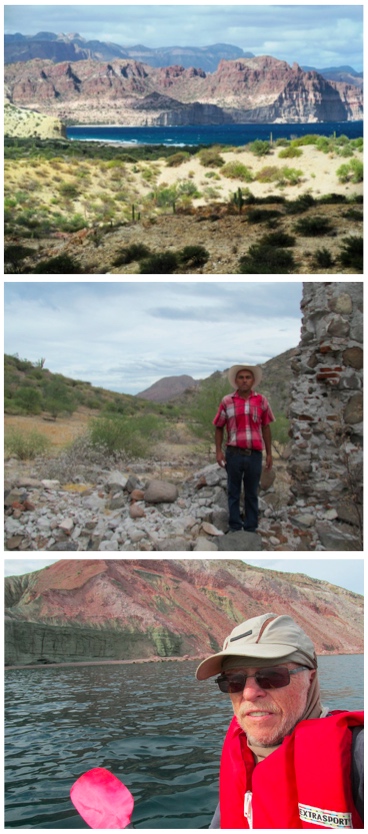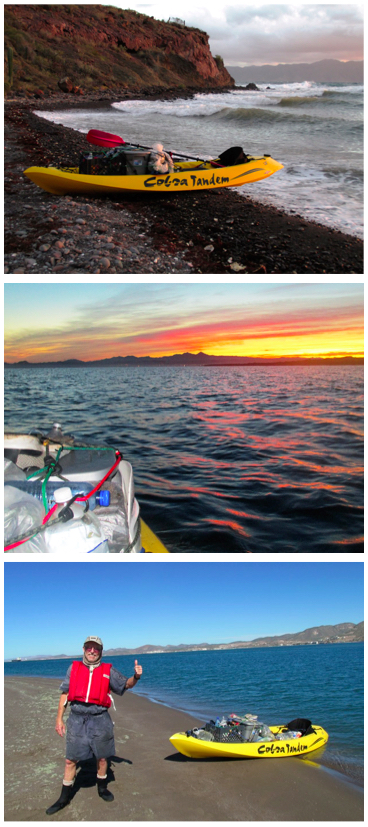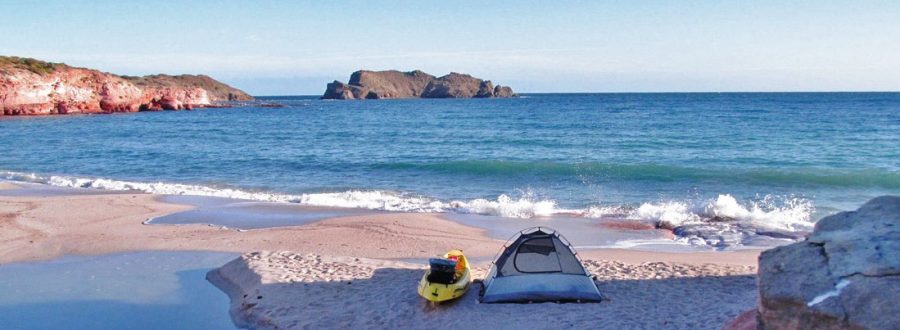Part 2: Santa Marta to La Paz
By Graham Mackintosh
Seen from the perspective of a kayak, the coast between Agua Verde and La Paz is often beautiful and colorful with numerous high cliffs and challenging headlands.
Sharing one protected headland—San Telmo—with the sailboat Schatzi, I made radio contact and was glad to make the acquaintance of intrepid sailors Roger and Lynne from Seattle, and their cute little dog Salty. Next morning, I paddled over to their boat and was able to pick up water and treats and the forecast that I had three relatively calm days before a major wind storm was due.
During that spell I landed on the beach at Dolores del Sur, left my kayak, and hiked a couple of miles inland to visit the remains of the old Jesuit mission. It was a place of memories. I had hiked up there in 1984 as part of my round Baja walk. I had photos of me standing by the same arches and walls.

Back on the beach, I was surprised by rain. So much fell so quickly there was no point trying to get my tent up. I covered what I could with tarps. Fortunately, I managed to make camp when there was a lull. Over an inch fell. But at least I slept warm and reasonably dry inside my tent. The sleeping bag and blankets were securely stored inside a “dry bag.”
Next day, rain threatened again, but knowing winds would be light, I paddled beneath a long line of massive cliffs towards the fish camps of Punta Alta and Nopolo. As always, I looked for places to land in an emergency. There were few. There was a monument to a drowned fishermen set into the cliffs. It was a reminder that this was no place to be when the weather turned ugly.
Again, I reveled in memories. Back in 1984, informed that there were places along the shore I could not possibly walk, I’d climbed up those awesome cliffs and tried to make my way along the top. I soon ran short of water and got into trouble. I was eventually rescued from the verge of heat exhaustion by a young Mexican who was up in those mountains rounding up his goats. He carried my pack and escorted me down a precipitous trail to his fish camp where his family looked after me till I was able to carry on.
I arrived at Punta Alta with my photos from 1984. And just about everyone I met was either in the photos or was related to those that were. I was informed that the fisherman who rescued me—Francisco Leon—had three grown children and was now living in Loreto. But I did meet his two brothers—Ishmael and Jose—on the water. They both greeted me as Pato Donald, a name I had used back then. Graham didn’t work too well in Spanish.
I didn’t always have a reliable weather forecast. Some mornings I’d pack and be ready to launch, not really knowing if the wind would settle or pick up. As packing would take at least two hours, it was a disappointment not to go. That happened twice south of Agua Verde. After all the work, it was difficult to call it off and make camp again.
Once, I set off and wished I hadn’t. Keen to get to go about four miles to the village of San Evaristo and pick up water and supplies, I launched in the dark into an increasingly wild sea and found myself battling Matterhorn-like waves bouncing back off the cliffs. Watching surf exploding against the base of those cliffs, I realized that I was a broken paddle, a misjudged wave, or a collision with a rock away from disaster. About forty minutes after I launched, I was glad to get safely behind a low headland, and ride the surf to shore. Apart from that one brief aborted attempt, I spent four days going nowhere, waiting for the wind and seas to subside. And that was the time to hike and explore and enjoy remote Baja.
Finally in San Evaristo, I paddled over to the water plant. A sign directs you to a nearby store and invites you to call Tony on VHF channel 16 to get water. Perfect. I filled every bottle and container I had. Tony was excited by a family shot I’d taken in 1984. “I think that’s me,” he said, pointing to one of the young kids. I gave him the picture.
From San Evaristo south, there was the comfort of a road generally less than a mile inland. Dramatic and fascinatingly colorful cliffs and mountains rise up from the shore. Punta Mechuda demanded the utmost generic viagra usa respect from kayakers. Long lines of colorful faulted cliffs alternated with occasional magnificent bays.
The road led to a big surprise. Thinking I had landed on a beach miles from anywhere, I was woken at midnight by a trio of youngsters from La Paz. They partied for a couple of hours more. I woke late and found them asleep surrounded by beer cans. I was glad when they drove out next morning, especially as the seas were too rough for me to depart. They told me they had come to see a meteor shower but much of the night was cloudy.
Next night was starry and clear, and tipped off to the event, I emerged from my tent in the dark and counted 14 shooting stars in 15 minutes.
 Next day, even though it was a little rough, I launched and headed to San Juan de la Costa, which was served by a paved road from La Paz. Several times I nearly chickened out and landed but in spite of a couple of good dunkings, I kept going. Again the attraction of a store and a water pickup was too much. When I finally pulled up on the beach in the small, spread-out mining town, it was gray and cold. I made an ugly surf landing. Looking like a drowned rat, I was wondering how I’d get my tent up, where the store was located, and how would I pick up water. And as so often happens in Baja, someone came to my rescue. A manager from Earth Ocean Farms, on his way to La Paz, saw me and kindly insisted I load my kayak and gear in his pickup and offered me the use of their facility which included hot coffee and warm showers. Tent and gear secure in their base, another employee drove me almost half a mile to the store and offered me all the drinking water I needed.
Next day, even though it was a little rough, I launched and headed to San Juan de la Costa, which was served by a paved road from La Paz. Several times I nearly chickened out and landed but in spite of a couple of good dunkings, I kept going. Again the attraction of a store and a water pickup was too much. When I finally pulled up on the beach in the small, spread-out mining town, it was gray and cold. I made an ugly surf landing. Looking like a drowned rat, I was wondering how I’d get my tent up, where the store was located, and how would I pick up water. And as so often happens in Baja, someone came to my rescue. A manager from Earth Ocean Farms, on his way to La Paz, saw me and kindly insisted I load my kayak and gear in his pickup and offered me the use of their facility which included hot coffee and warm showers. Tent and gear secure in their base, another employee drove me almost half a mile to the store and offered me all the drinking water I needed.
For two days I waited out the wind and rain, and enjoyed the security of my surroundings, hearing about all the fish they were farming in their submersible cages in the nearby sea.
The forecast was marginal for a week. But I was in no mood to linger that long so close to La Paz and Christmas with friends. I had to launch on a slippery concrete ramp in surf with rocks on either side. Any miscalculation and I could roll the kayak and spill everything I carried on the deck into the sea. I got wet… but I was underway. La Paz was 35-40 miles away.
The day warmed, the cliffs ended, and then the Mogote peninsula beckoned. It was a long exposed coast. Reckoning I was about halfway to La Paz I ran ashore early afternoon when the wind picked up. I got wet launching and landing but had time to more or less dry out before evening.
I had phone and internet service from La Paz. Next day, the wind was forecast to pick up strongly around noon and blow for days. Knowing there was a major resort at the end of the Mogote I was determined not to be forced ashore needing to camp surrounded by condominiums.
Last day… or what I hoped would be the last, I was awake and packing shortly after 2 AM, ready to launch in the dark at 4 AM. At first, there was a reasonably gentle south wind, but then it blew stronger… and colder. Paddling hard towards the lights of La Paz provided some warmth. I was glad to see the sunrise. I found myself paddling with three whale sharks, and then dozens of playful dolphins.
The tour boats were soon out from La Paz. I kept looking at the shallows and the long rolling surf knowing if the north wind caught me, for safety I’d have to run ashore.
Fortunately, the north wind held off till I got inside La Paz Bay. I was on the Mogote, delighted to look across at the big city, and within twenty minutes the wind was blowing hard. Instead of forcing me ashore, I was able to run with it and cross the bay to my friends waiting on the other side.
It was good to have a hot meal and a warm bed without putting my tent up. But it had been wonderful to relive so many memories from 35 years earlier and to look back on a new adventure… paddling alone, in an overloaded sit-on-top kayak, along all the Sea of Cortez from Bahía Gonzaga to La Paz.
Read Part 1 of Graham’s “Loreto to La Paz” kayaking adventure, or enjoy other articles written by Graham Mackintosh.

